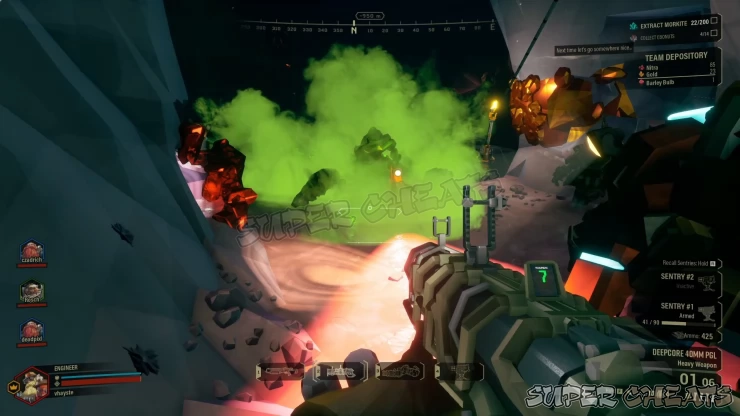Damage and Effect Types Guide
Deep Rock Galactic is an amazing dungeon crawler-shooter where you can play as one of the four dwarven types (class) while digging through procedurally-generated caverns and tunnels in mineral-rich locations in space. However, digging for resources and valuable items are just half the battle; you’ll also need to fight to protect yourself and your crew from the many dangerous creatures residing in different biomes. In this page, we will discuss the different damage types and how they can affect combat.

Kinetic
Weapons that release bullets and pellets deal kinetic damage. This is a very standard damage type and there are no special effects or properties for this type of damage; just plain gunpowder and iron to perforate the bugs you’ll encounter.
Melee
Basic mining tools like the standard pickaxes and drills can be quite effective in close combat encounters. Melee damage is particularly effective against Frozen enemies. As they say, if it can mine, it can kill.
Fire
Fire deals damage over time. Furthermore, the creature on fire becomes another source of heat that can spread the immolation to other creatures as well. The fire will die out on its own automatically unless a new source has been ignited on the same target. Take note that creatures can’t be set ablaze instantly. Some weapons and environment hazards will raise the temperature of the creature (including dwarves). If the temperature gets high enough, the affected creatures will ignite and set ablaze.
Cold
As a direct opposite of Fire damage, creatures affected by cold don't Freeze instantly. Some weapons and environment hazards can lower the temperature of creatures (including dwarves). When a creature’s temperature gets low enough, the creature will Freeze. Frozen creatures can’t act nor move, and will also suffer extra damage from melee attacks. It’s also worth noting that creatures affected by the cold will slow down before freezing.
Armor Breaking
There are special types of ammunition that have Armor Breaking effects. These ammunition are specially-made for tough carapaces of certain bugs. They’ll pass more damage against targets with Light Armor and will quickly shatter enemies with Heavy Armor. However, they’re completely useless against special enemies with Unbreakable Armor.
Temperature Shock
This damage is triggered when there’s a sudden temperature change on a target. Whenever a creature that’s forced out of being Frozen or Burning states via a strong source of Fire or Cold (respectively), the temperature shock will deal extra damage to the target.
Explosive
As the name suggests, this damage type comes from explosive blasts. Explosions will deal AoE (area-of-effect) damage from the impact point, with the damage even more severe near the center. This type of damage is best used against groups of enemies. Be careful of the collateral damage that can be inflicted to allies. A majority of explosions will destroy any terrain they hit, creating footholds or loosening up any precious minerals tucked in them.
Stun
Stun damage can interrupt the target’s movement and attacks for a few seconds. There are weapons and grenades that can stun enemies. Be warned of enemies that can deal stun damage to dwarves as well.
Electrical
Some weapons and environmental hazards produce electric discharges that can damage any creature or dwarf that comes in contact with them. Prolonged exposure to those sources may inflict Electrocution. In this state, the affected creature will slow down while also suffering from DoT (damage-over-time) until the status wears off.
Fear
Certain types of ordnance like explosives can startle and temporarily scare creatures away, making them ideal for crowd control. Fleeing creatures will become vulnerable targets; however, there are some creatures (usually the bigger ones) that are less likely to get frightened.
Radiation
Most creatures exposed to radiation will suffer from damage over time. Be careful of heavily mutated bugs that became radioactive sources themselves.
Pheromones
This special concoction is made from extracts of Dreadnought bile mixed with a ton of noxious chemicals. When used on enemies, this will cause their allies to temporarily turn on any of the allies affected by the chemical.
Poison
Poisonous gasses are often volatile and breathing them in will deal continuous damage until the effect wears off. Artificially-created poison called Neurotoxin will poison enemies and slow them down at the same time.
Push
While not able to deal huge amounts of damage, this type of attack or explosions can launch dwarves into the air. Since there’s considerable fall damage for landing from heights, you’ll only have a few seconds to properly react to avoid getting heavily damaged or dying. Consider using traversal tools at the right moment to get into a safe position after getting pushed or launched in mid-air.
Grab
There are a few enemies that are capable of grabbing dwarves and dragging them around. While the best strategy is always prevention, once you’re grabbed, you can only hope for your allies to assist you or pray that you get dropped on a safe spot. If you have the “Heightened Senses” perk, you’ll get a warning if an enemy is about to grab you and also allow you to escape the grab and kill your captor.
Slowdown
This temporarily reduces the movement speed of the target. While you’ll get slowed by viscous substances found in the environment or excreted by bugs, there are other effects like inflicting Cold (not frozen) that can slow down any creature too. Having the perks “Iron Will” and “Dash” will help you ignore slowdown effects for a short period of time.
Defense
There are enemies that regenerate the health of their allies or improve their damage resistance. This can be a problem in the long run so prioritize locating the source and destroying it immediately to end the buffing effect.
Anything missing from this guide?
ASK A QUESTION for Deep Rock Galactic
 Join us on Discord
Join us on Discord
